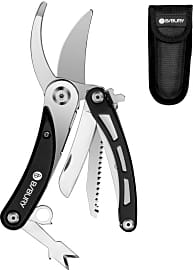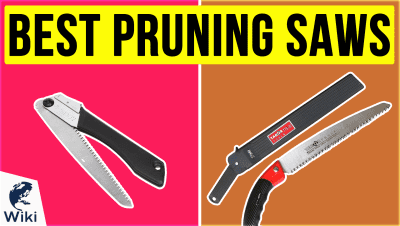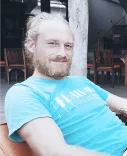The 10 Best Pruning Shears

This wiki has been updated 44 times since it was first published in April of 2015. If you have a green thumb and are planning on doing some tidying up in the garden this year, take a look at these pruning shears. They provide blades that are easy to wield in one hand and can help you get rid of unwanted leaves, branches, and stems. Whether you need to cut through thick, dead limbs or just snip a few petals, this selection offers an appropriate pair. When users buy our independently chosen editorial recommendations, we may earn commissions to help fund the Wiki.
Editor's Notes
March 26, 2021:
When choosing a suitable pair of pruning shears, comfortable grips and sharp blades are the obvious factors to consider. Beyond that, blades that can be replaced or resharpened will ensure the longevity of the tool, while choosing a pair that are sized correctly for the user will reduce the risk of accidents and minimize hand fatigue.
In this recent update to the ranking, we assessed our current selections and replaced any that are not performing as expected. For cutting through dense foliage or dead branches, curved blades are more effective than straight ones, as they concentrate the force at the point of contact. The Bibury 5-in-1 and the Corona Classic are good general-purpose options with strong curved blades. If you're looking for something a little more durable, then the Okatsune 101 Bypass is made from Izumo Yasuki Japanese steel, which is extremely strong and durable. We replaced the popular ARS Signature with the ARS VS-8XZ, which has been improved with the addition of a tensioning plate on the back of the center bolt to maintain optimal torque. For light pruning or shaping, a smaller pair will make the task easier and more precise. Both the Hydrofarm Precision and the Gardenite Ultra Snip have very sharp straight blades made from stainless steel, and are ideal for fitting into tight crevices. Finally, we replaced the Fiskars Steel with the newer Fiskars Power-Lever. They boast an anvil design that maximizes leverage to provide up to twice the cutting power, making them the best choice for thick branches that otherwise would require cutting with a saw.
January 10, 2020:
If you tend to a garden on a regular basis, or if you're in the landscaping industry, there's no doubt that you understand the value of a good pair of pruning shears. Shears are essential for controlling small growth on trees, vines, flowers, and shrubs. A plant can flourish only if it's properly cared for, after all.
Pruning is important for several reasons. First, it helps sunlight reach parts of the plant that may be obscured by unwanted growth. Similarly, air contains essential nutrients that can become difficult to absorb as foliage densifies. It's also important to remove dead leaves and branches because they are susceptible to disease. Finally, you'll probably want to shape the plant you're caring for to suit the aesthetic of your home or business. If you're just testing out your gardening skills, a full garden tool set may be a smart investment.
The Gardener's Friend Ratchet and Basilica Botanica BB-002 got the ax due to user reports of premature dulling. The Fiskars 9109 has been removed and replaced with the Fiskars Steel, an updated model. Other new additions to the list include the Gonicc Premium and Bibury 5-in-1, chosen for their ergonomic design and versatility, respectively.
Special Honors
kaneshin Bonsai Tools This Japanese company supplies all the necessary tools and accessories for bonsai cultivation. Their selection of trimming and pruning shears are made from the highest quality Japanese steel and are suitable for a whole range of garden uses. kaneshin.com
EZ Kut Whether working in your garden or on large-scale landscaping projects or setting up camp in a remote area, EZ Kut's range of pruning, loping, and sawing tools are all extremely high-quality and come with their unconditional lifetime guarantee. ezkut.com
Why Plants Need Pruning
Research has shown that once substantial amounts of auxin exist in the main stem, it will not accept any more.
Pruning is a process of selecting and cutting specific branches on a plant to stimulate new growth and encourage it to become more bushy. It may seem counter-intuitive to some, but cutting a plants growing stalks can be one the best ways to make it healthier and cause it to produce more fruits or flowers.
When a plant grows naturally, without any external factors inhibiting or shaping it, the main stem dominates the plant's growth. In doing so, it also inhibits the growth of the lower branches. Many people think this is because the top stem is closest to the light source, and therefore completes more photosynthesis. This is actually untrue. The main stem dominates growth solely because of the fact that it was there first, which makes it stronger and more vigorous than the others.
A hormone known as auxin is released by the actively growing tips of a plant and transported down into the main stem. This is the chemical that is responsible for inhibiting the growth of other branches on a plant. In order for a growing shoot to be active, it must be able to export its auxin into the main stem.
Research has shown that once substantial amounts of auxin exist in the main stem, it will not accept any more. The top stem in an unpruned plant is the most vigorous and fills up the main stem with its auxin. This means that the less vigorous branches cannot export their auxin, hence they cannot grow very much.
When the upper branches of a plant are pruned, they stop producing auxin for a short period of time while they focus on healing. This gives the lower, less powerful branches a chance to export their auxin, resulting in vigorous growth. Regularly pruning a plant will cause it to become more bushy, and since the lower branches become stronger and healthier, it will also cause a plant to produce more flowers or fruit.
Understanding The Different Types Of Pruning Shears
Many gardeners find pruning shears to be one of the handiest tools in their arsenal. It is not uncommon for amateur gardeners to start out using just a pair of craft or kitchen shears, but sooner or later, one will need to cut back hardy wood stems, and then a good pair of hand pruning shears will be invaluable.
This gives them more leverage than either of the other two types and makes them ideal for those with smaller or less powerful hands.
Pruning shears come in three types; bypass, anvil, and ratchet. The most popular form are bypass pruners. They feature two curved blades which bypass each other when closing. Either one or both of these blades can be sharpened, which allows them to make a nice clean cut and makes them ideal for green shrubbery. Unfortunately they do not provide much additional leverage when cutting, so they can be hard to use on dead wood.
Anvil pruning shears feature one straight, sharpened cutting blade which closes against a flat, dull anvil. They are designed to hack through branches with a crushing motion, unlike the cutting motion of bypass pruning shears. This makes them work well on tough dead branches, but not a good choice for living stems as it can damage them. Anvil pruning shears are also often bulkier than bypass shears, which can make it difficult to get them into tight spots.
Ratchet pruning shears are generally a variation on anvil pruners, but they feature a ratcheting mechanism that allows the cut to be performed in stages. This gives them more leverage than either of the other two types and makes them ideal for those with smaller or less powerful hands. They are also a good choice for someone who will performing a lot of pruning.
How To Care For Pruning Shears
Proper care and maintenance of pruning shears is vital to keeping them in good working order for years to come. While unmaintained shears may become unusable after just a few years, a well maintained pair can last a lifetime.
This can be adjusted by tightening or loosening the center screw located at the base of the blades.
One of the most important preventative maintenance steps a person can take is to clean and oil their shears after they are finished using them for the day. First start by wiping off any debris with a dry cloth. Then use warm soapy water or fine steel wool to remove any plant sap. There are also a few other surprising household items that can remove tree sap. After drying the blades, apply some mineral oil to the blades, the closing mechanism, and the spring. If one doesn't have mineral oil, any household oil can be used.
If you notice that more effort is required to cut through branches then when the shears were first purchased, it is mostly likely time to sharpen the blades. This can be accomplished with a diamond hand file or sharpening stone. Following the factory bevel angle, run it along the length of the blade a few times. After it feels sharp, run the sharpening stone along the flat side of the blade to remove any burrs.
Another thing that can make it harder to make a cut is overly tight tension between the blades. More often than not though, pruning shears tend to lose tension over time instead of tightening. If branches begin to bind between the blades when closing instead of being cut, most likely loose tension is to blame. This can be adjusted by tightening or loosening the center screw located at the base of the blades.















